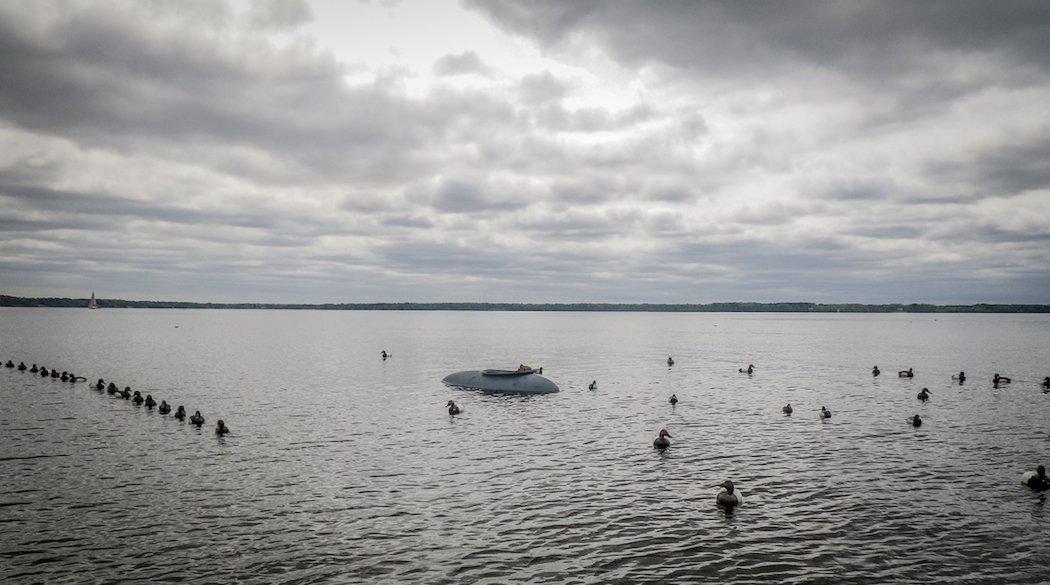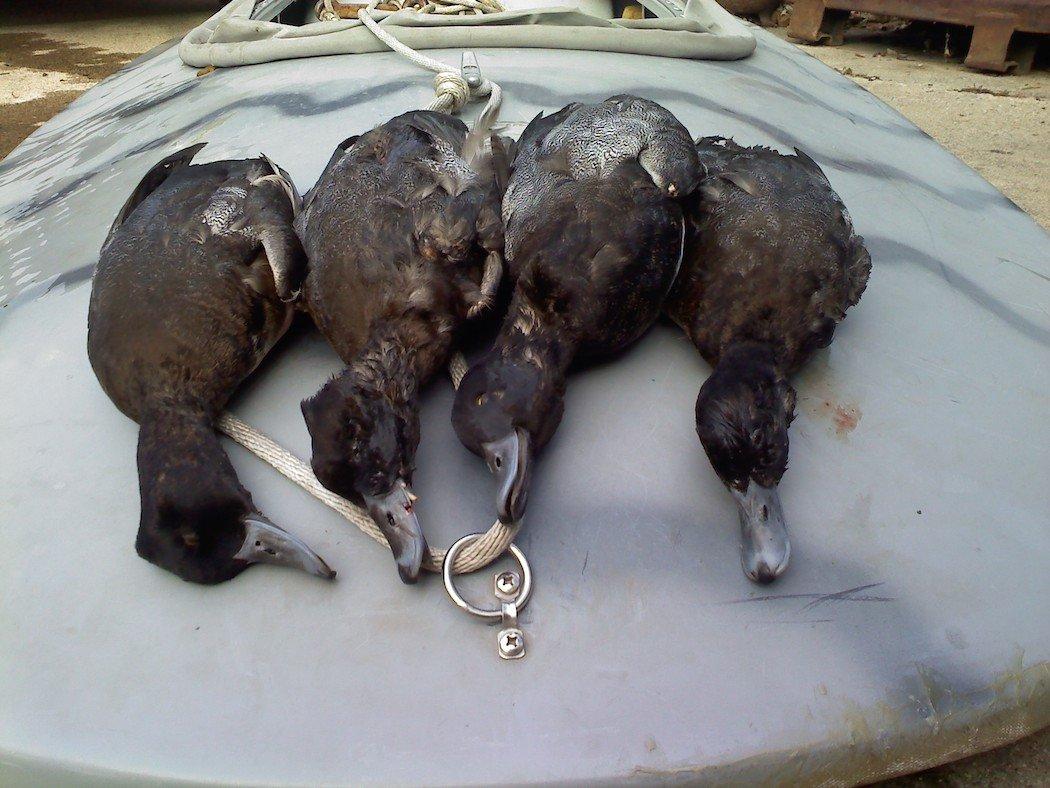GET THOSE DUCKS THAT ARE WAY OUT THERE
You've probably watched a flock of diving ducks see your decoys, bank against the wind, fly at your spread…and then land 100 yards away. That's the diver hunter's dilemma: Getting ducks that naturally feed, loaf, and find safety in open water to fly near points, shorelines, or an island. And after seeing flock after flock of birds land short or skirt the edge of your blocks, you wish you could be out there with them. You can. By adapting your tactics and equipment, you can hunt diving ducks—scaup, ringnecks, redheads, canvasbacks, buffleheads, goldeneyes, and even sea ducks—on the open water of lakes, rivers, and flowages. Here's how.
GETTING WITH THEM
This game differs considerably from shore hunting. First, you obviously have no natural cover when you're a half-mile from shore. Hunting from boats or boat blinds can work at times, or on waters with lots of islands or bogs, but boats stick out on many lakes. And although most divers aren't as savvy as late-season mallards, they flare from unnatural scenes—especially if they've been shot at.
Layout boats offer a huge advantage. These specialized low-profile crafts almost eliminate your outline and let you lie amongst your decoys. With the sun at your back and a light chop on the water, they almost disappear.
Logistics and equipment are the main challenges in layout hunting. First, you need a large boat, called a tender craft, to transport hunters, decoys, and the layout boat. Any good-sized fishing boat will do, but I'd recommend using at least a 16-foot Deep-V. Larger crafts are preferable.
THE RIGHT DECOY EQUIPMENT
You can use independently rigged decoys, but pre-rigged multiple-decoy lines save an immense amount of time and work. Several retailers offer great line and leader options, but the best come from Doctari Longlines in South Milwaukee, Wisconsin. Doctari uses large lobster clips on its leaders, making it easy to attach and detach decoys.
Figure out the depth of the water you plan to hunt, and leave plenty of line between your weight and the first decoy on the line. I typically hunt a lake with a maximum depth of 21 feet, so we leave around 25 feet of line. Any large decoy weight should sufficiently anchor your mother lines, but if you hunt rocky or otherwise snag-filled waters, old-fashioned window sashes work best. They're heavy, but you can drag them over obstructions.
Set up your lines so you can transport as many decoys as your boat will safely haul. You won't need quite as many blocks as when shore hunting, but you'll want at least four dozen, strung on four lines. Five or six dozen, rigged on as many lines, are preferable. Store your pre-rigged long lines along the rails and deck of your boat, or coil them into large lawn bags. The key is making sure the decoys and mother lines don't tangle.
Most layout hunters first anchor their layout boat and then set decoy lines around it. I've seen some folks do the opposite. It really doesn't matter, provided you leave plenty of space and maneuvering room between the boat and decoy strings. Trust me, you do not want to catch a mother line or layout anchor rope in your prop when it's 20 degrees.

My favorite layout spread features two lines of decoys to the right of the boat (assuming most shooters are right-handed), with the inside line extending a bit upwind of the boat to hide it. Then, leave a good-sized gap to the left of the boat—think landing area—and run four strings of decoys on that side. Start the inside line at or slightly upwind of the boat, and then stagger subsequent strings downwind a yard or two. This breaks up the blocky appearance of straight lines a bit. If it's calm or birds seem spooky, consider placing a few singles in the open pocket in front of the layout boat, behind the spread or outside the lines.
POSITIONING HUNTERS
When your spread is set, get the first hunter in the layout boat. Motor very slowly toward one side of the boat—preferably from downwind so you can better control your drift—and then stop or hold the boat in place so the hunter can step inside the layout. Then hand him his unloaded gun and shells.
When the hunter is set, the tender-craft operator becomes the hunt supervisor, watching the shooter from a distance. Typically, a few hundred yards is sufficient. When the hunter shoots a bird, the tender-craft operator pulls anchor and motors toward the downwind head of the spread. It's easy to see the white bellies of dead diving ducks bobbing in the waves, but cripples can be tough to spot. That's why it's wise to use two-way radios so the hunter can communicate to the boat operator where his duck is and whether it's dead or diving. Use a large fishing net to retrieve dead birds. You might be tempted to take your dog layout hunting, but don't. A dog only gets in the way.
After you learn how to set up in open water, the big question becomes where. The obvious answer, of course, is where you see good concentrations of diving ducks. That's fine, but try not to hunt where divers roost. You might enjoy one great hunt, but you'll blow birds out of that area for a while—possibly the season. It's far better to identify areas where ducks feed, loaf, or trade to and from roosting and feeding areas—much like setting a deer stand along a route a buck travels from bedding and feeding spots. By doing this, you'll intercept ducks that are moving naturally and looking for company, not hazing previously content birds.
THE CAVEATS
First, open-water hunting regulations vary from state to state or water to water. Get a firm grasp on what's legal in the area you plan to hunt.

In addition, many divers get a bad rap as table fare, and that's unfortunate. Canvasbacks might be the tastiest North American duck, and redheads and ringnecks are also consistently good. Bluebills—even those that dine on mussels or other crustaceans—are tasty if you trim away all fat from the meat, wash out bloodshot areas, and soak them in salted water for a day or so, changing the water often. Buffleheads taste a bit more like liver but are also good eaten fresh. Goldeneyes and sea ducks can be strong tasting, so it's wise to marinate their meat or chop up the breasts for stew or stir-fry. They're also good candidates for jerky or sausage.
Finally, be safe above all else. Plying choppy 35-degree water is dangerous business. Don't overload your craft, and always wear your life jacket. If the wind or weather looks troublesome, don't go out. Wait until conditions get right. No limit of ducks is worth even the slightest chance of risking your life.







